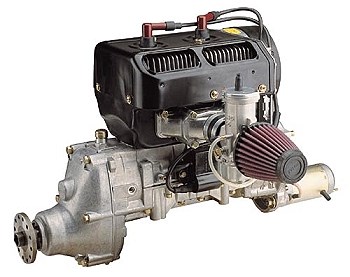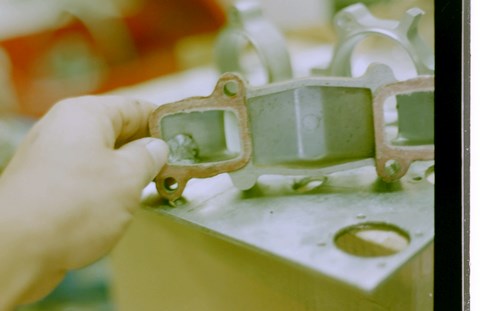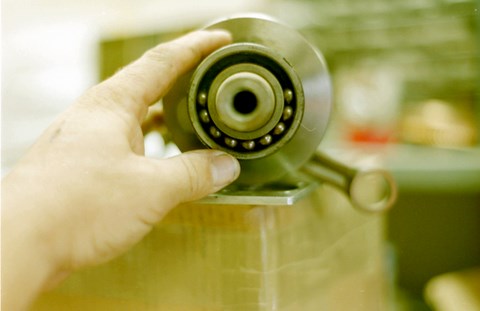Rotax 377, 447, 503 troubleshooting
Several ultralight pilots have reported prop damage, overheating, and or rattling, on aircraft powered by the 377/447 Rotax engines. Upon closer inspection it was found that the lower cylinder and or upper cylinder cowl housing had:
1. cracked causing a rattling noise to be heard when running the engine
2. broken off resulting in pieces flying into the prop in pusher configurations damaging the prop.
3. found their engines overheating due to lack of proper air flow over the cylinders. The only solution available is to replace the fan shroud housing with a new one. There is however a steel housing available which has proven to be stronger than the aluminum ones used on most engines. The reason for the use of the lighter cowling was to help US manufacturers in meeting the legal weight requirements.
Rotax introduced a new engine cowling for use on the 377,447, and 503 engines which directs more air to the magneto cylinder, making for a cooler running engine.
Several ultralight pilots have reported rough running engines, and or engine failure. Upon closer examination it was found that the aluminum intake manifold, on the single carburetor equipped 377/447/503 had cracked in the area of the bolts used to fasten it to the cylinders or at the point where the outer half of the manifold joins to the inner half on the 503.
The cause of the problem, can be that when the Rotax engine is disassembled and then reassembled a special alignment tool is required to properly align the cylinders before torquing the heads. (Another commonly reported problem is in the improper torquing of the head bolts.)
The proper procedure is to first align the cylinders using the alignment bar, torque the head bolts, (to the specifications found in your service manual) replace the cylinder shroud cowlings, and then replace the exhaust and intake manifold.
Without first aligning the cylinders before torquing the heads, the cylinders do not line up with the holes for the aluminum manifold. Thus when the manifold is tightened, because the holes are off ever so slightly, the manifold cracks. This allows air to enter the engine causing a lean mixture, overheating, and possible engine seizure. It is strongly recommended that if you are removing the manifold, cylinders, or heads that you properly align them before retightening to proper specifications.
Heading Here
Another reported problem in the intake and manifold area is with the gaskets used to seal the area between the manifolds, engine cowlings and engine block assemblies. On the 377/447/503 engines little tabs are designed into the shroud housings to allow the engine assembler to place the gaskets into them to help retain them during installation.
Because of the gaskets location in behind the cowling, they are very difficult to position, in some instances (where a mechanic is unfamiliar with the Rotax engine) the gaskets have been allowed to slip down, and thus are not sealing properly (never use sealant on any of these gaskets). This leakage on the intake side, can lead to a lean fuel mixture resulting in overheating and possible seizure, with an exhaust leak having the potential to do the same.
If you are installing these gaskets make sure that they are installed properly using these tab, and it is recommended that new gaskets be used on anything but a relatively new engine.
Paragraph title
Another commonly reported problem with the 377/447/503 engines is with the disintegration of the bottom end crankshaft bearings.
In nearly all cases the engines are installed on aircraft such as the Eipper MX, Rotec Rally and Skyseeker where a driveshaft is used, or on the Challenger where a drive belt system is used. Some manufactures have updates available to help eliminate this problem.
The life of the crankshaft end bearings appears to be considerably shorter when used in these types of drive systems. Again first hand experience has shown that very seldom are the bearings destroyed to this extent when a Rotax gear drive is used. It has also been our experience that the type of engine oil used can play and important role in extending the life of the crankshaft bearings.
Paragraph title
Some oils especially those recommending a 100 to 1 mixture (the factory recommendations is a 50 to 1 mixture) have shortened the life of these bearings to less than 40 hours, while the rest of the engine is still in relatively good shape.
Synthetic oils have shown to reduce carbon deposits in the engine, but my experience has been that they do not seem to have the same lubrication qualities as mineral oils, when it comes to the crankshaft bearings.
As well synthetic oils do not appear to have the same lubrication qualities as a good grade of mineral oil when it comes to storage.
On engines that have been stored over the winter, where synthetic oils were used, we have reports of rust forming on the crankshaft and wrist pin bearings.



